Get new posts by email or rss feed
Thanks to the team for all the work they put in figuring out the protocol, running the experiments, and analyzing the data: /u/genetastic and /u/kabong!
Summary
A reader, /u/genetastic, reached out about collaborating on experiments to determine the effect of vinegar on blood glucose after meal consumption.
Like most of you, I had heard all the nigh-magical, pseudoscience claims about using apple cider vinegar to treat diabetes. However, when you dig into the literature, there’s a sizable number of peer-reviewed studies, including several decent meta-analyses, showing that consumption of vinegar with a meal can reduce the blood glucose impact in both diabetic and non-diabetic subjects (see background below for details). There’s also a lot of open questions, including:
- Is the effect large enough to matter for practical meals?
- What types of meals does vinegar affect?
- What is the best protocol to get a large effect without unpleasant side effects?
- What’s the underlying mechanism?
- Is the effect specific to vinegar or do other acids work?
/u/genetastic, a third collaborator /u/kabong, and I decided to answer these questions with community self-experiment.
For the first phase of this experiment, we wanted to check that we could observe the reported impact of vinegar on blood sugar and that the effect size was large enough to be worth further study.
Towards this end, all three experimenters tested consuming regular white bread with and without apple cider vinegar (the most commonly tested meal and vinegar source in the literature).
Here’s a summary of the results & next steps (full details below):
- We observed a similar effect of vinegar on blood glucose as that reported in the literature.
- The effect was observed for both experimenters with diabetes (/u/sskaye, /u/kabong) and normal metabolism (/u/genetastic)
- The effect was both statistically significant and meaningful in magnitude, justifying further study of the scope, mechanism, and optimal protocol.
- Peak change in blood glucose & iAuC were reduced by 20% and time to peak blood glucose & initial rise were slowed by 15-20 min. (30-50%).
- P-values were all <0.05, with the exception of the drop in iAuC, which was 0.12
- Next, we will be looking at the following:
- Diluting vinegar to make it more palatable
- Alternate macronutrients (simple sugars, proteins) to determine scope of the effect
- Alternate acid sources to test the amylase-inhibition hypothesis
All-in-all, a good start to the study. The effect seems to be real and likely caused by a slowing of the initial rise/rate of metabolism.
We’re also see a lot of value to running the experiment as a team rather than my more typical N=1 study. With most of my experiments, there’s always a concern that the results are specific to my body chemistry and won’t generalize to others. Having data from multiple people significantly reduces that risk.
That said, having data from multiple participants significantly complicates the analysis. Luckily, /u/genetastic is much better at statistics than I am and was able to handle it.
It would significantly improve the study to have a larger number of participants. If you’re interested in collaborating on this or other scientifically rigorous self-experiments with low-carb foods, supplements, or other health interventions, please let me know in the comments or via the contact form on the right.
– QD
Details
Purpose
- To replicate (or fail to replicate) the existing literature and quantify the effect of vinegar on blood glucose level after consumption of complex carbohydrates.
- To better understand the underlying mechanism by determining how this effect varies with person/metabolic status, dose, source of calories, and type of acid.
Background
Link to list and summaries of literature reviewed
Over the past 20 years, several clinical trials have shown that consumption of vinegar with a meal can reduce the post-meal blood glucose concentration on both non-diabetic and diabetic patients. A meta-analysis of 11 high-quality studies showed a significant and systematic reduction in glucose and insulin area under the curve (see Figures 1 & 2).
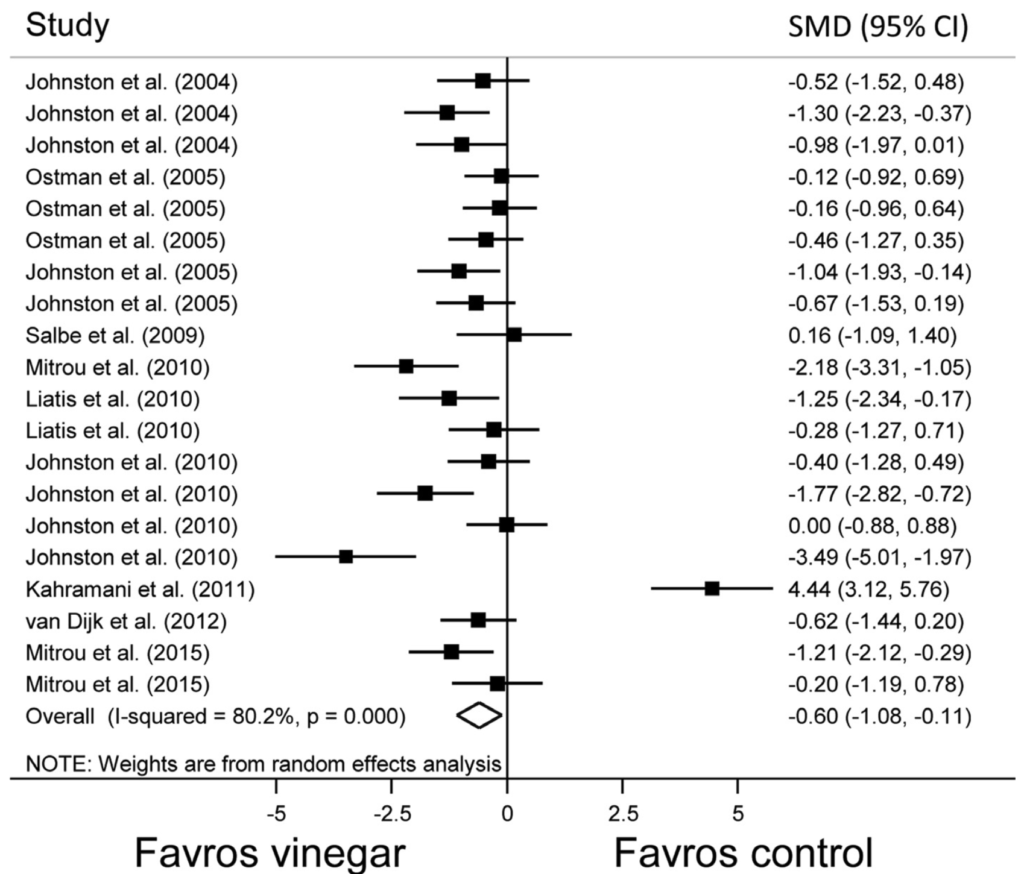
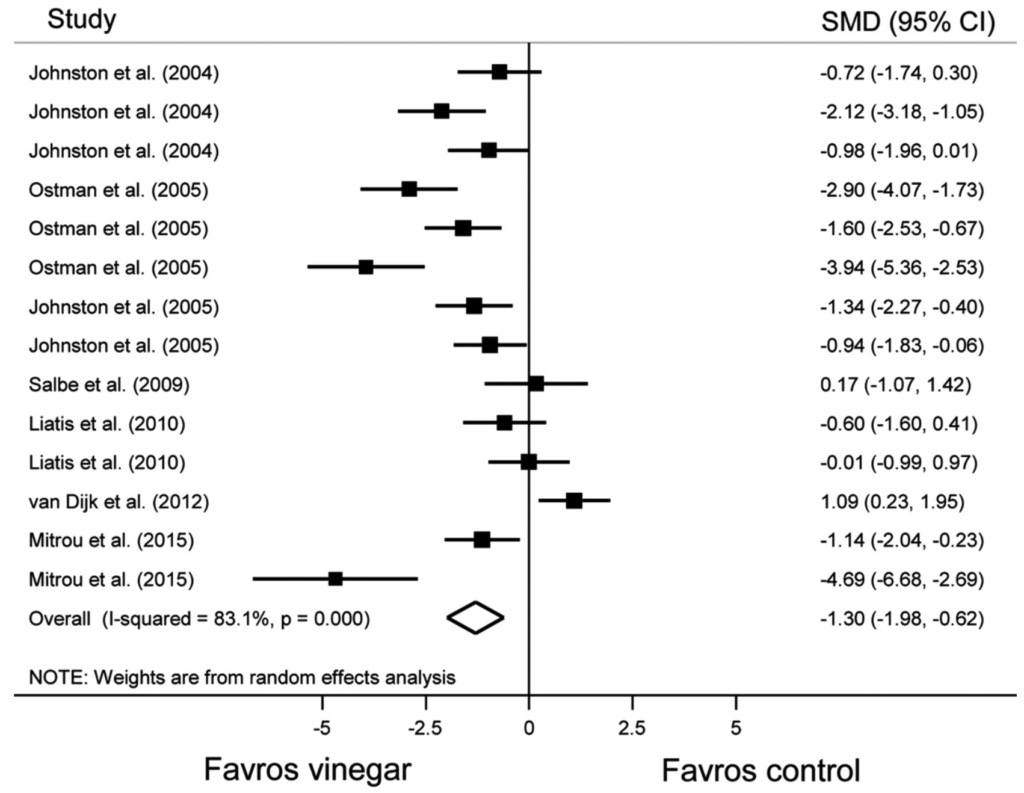
Based on this, I believe that vinegar has an effect. However, there’s no clear consensus on how or why vinegar lowers blood glucose. Various mechanisms have been proposed, including:
- Delayed gastric emptying
- Increased glucose uptake by muscles
- Inhibition of alpha-amylase, leading to slower breakdown of starches
I’m particularly intrigued by the work of the Le Feunteun group, that argues that the effect is not due to vinegar specifically, but rather reduced pH slowing the breakdown of starch by inhibiting the enzyme alpha-amylase. Supporting this claim:
- They did some really nice in-vitro studies showing that alpha-amylase is inhibited by pH and that when it’s inhibited starch breakdown and sugar release is slowed significantly.
- They then tested this in humans with lemon juice and showed the same inhibition and delayed starch breakdown, along with a reduced BG impact similar to that observed with vinegar.
- Separately, other groups have shown:
- All together this is decent evidence for the acid as inhibitor of alpha-amylase as mechanism hypothesis
One of the biggest challenges in the vinegar/acid literature is that all of the experiments were done with different meals, protocols, and doses, making it difficult to integrate data from multiple studies. To address this issue and answer some of the open questions about this effect, /u/genetastic, /u/kabong, and I decided to do a series of community self-experiments.
While we each have different motivations and interests, overall, the questions we’re looking to answer are:
- Is the effect large enough to matter for practical meals?
- What types of meals does vinegar affect?
- What is the best protocol to get a large effect without unpleasant side effects?
- What’s the underlying mechanism?
- Is the effect specific to vinegar or do other acids work?
To answer these questions, we conducted experiments using the protocol below.
Results & Discussion
Phase 1: Literature Replication & Measurement of Effect Size
Before we could start evaluating the effect of different foods, protocols or determining the underlying mechanism, we first had to confirm that we could observe the reported impact of vinegar on blood sugar and that the effect size was large enough to be worth further study.
Towards this end, all three experimenters tested consuming regular white bread with and without apple cider vinegar. This was the most commonly tested meal and vinegar source in the literature and so we felt it gave us the best chance of seeing an effect.
As this was a community experiment, each participant had different lifestyle, necessitating different protocols. Details are provided in the Methods section below. Most notably:
- /u/genetastic used 50g white bread and 80g water with or without 23g apple cider vinegar
- /u/kabong used 47g white bread and 30g apple cider vinegar or water
- /u/sskaye used 16g white bread soaked in 30g apple cider vinegar or water
- Note: /u/sskaye found this concentration of vinegar to be extremely unpleasant to consume.
Blood glucose traces for all experiments are shown in Figure 3. By visual inspection of the data, consumption of vinegar with white bread results in a consistent slowing of the blood glucose rise and lowering of blood glucose impact for /u/sskaye, a less consistent but noticeable effect for /u/genetastic, and no clear effect for /u/kabong.
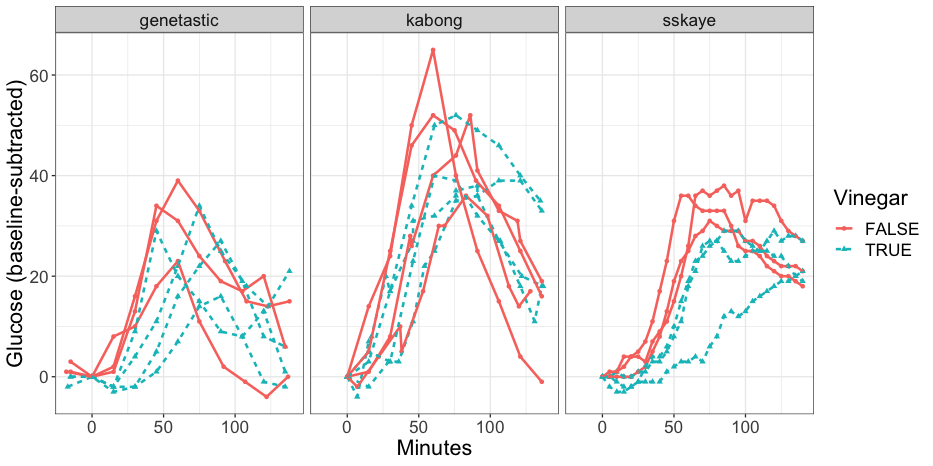
To get a more quantitative measure of the effect, peak change in blood glucose, time to peak change in blood glucose, time to +10 mg/dL (initial rise), and integrated area under the curve (iAuC) were calculated. The resulting data were fit to a linear mixed-effect model and t-statistics and p-values were calculated using Satterthwaite’s method. Results are shown in Table 1 and Figures 4, 5, 6, & 7.

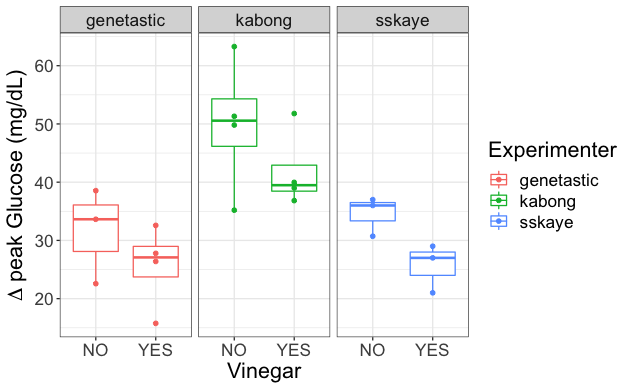
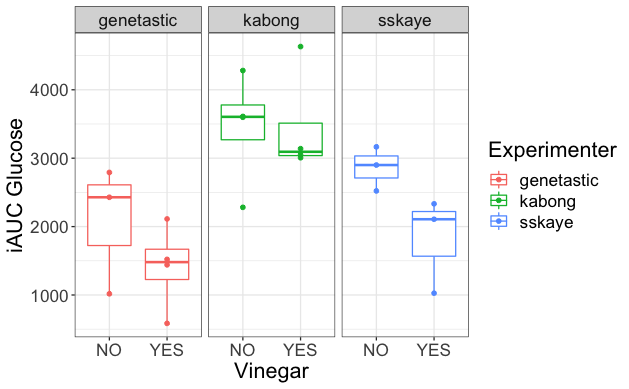
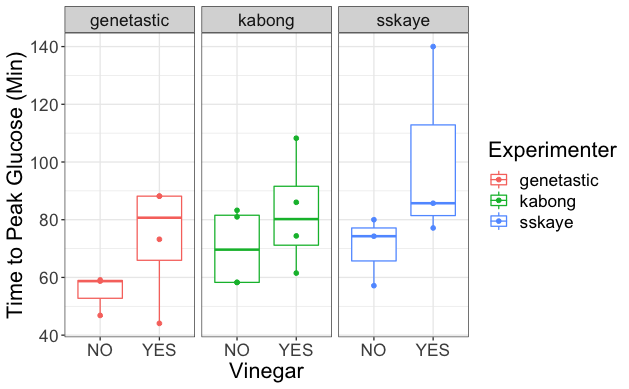
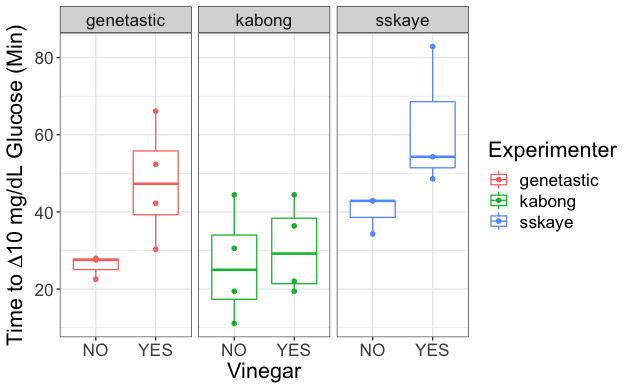
The effect of vinegar on blood glucose is both statistically significant and meaningful in magnitude. Peak change in blood glucose & iAuC were reduced by ~20% and time to peak blood glucose & initial rise were slowed by 15-20 min. (30-50%). P-values were all <0.05 with the exception of the drop in iAuC, which was 0.12, suggesting the effect is unlikely to be due to chance.
Conclusions & Next Experiments:
Based on this, effect seems to be real and likely caused by a slowing of the initial rise/rate of metabolism. Next steps are to repeat with a more palatable protocol, then look at dose-response and whether it works with glucose.
- We were able to observe a similar effect of vinegar on blood glucose as that reported in the literature.
- The effect was observed for both experimenters with diabetes (/u/sskaye, /u/kabong) and normal metabolism (/u/genetastic)
- The effect was both statistically significant and meaningful in magnitude, justifying further study of the scope, mechanism, and optimal protocol.
- Peak change in blood glucose & iAuC were reduced by 20% and time to peak blood glucose & initial rise were slowed by 15-20 min. (30-50%).P-values were all <0.05, with the exception of the drop in iAuC, which was 0.12
- Next, we will be studying the following:
- Diluting vinegar to make it more palatable
- Alternate macronutrients (simple sugars, proteins) to determine scope of the effect
- Alternate acid sources to test the amylase-inhibition hypothesis:
– QD
Methods
The original experimental design was pre-registered here. The following changes were made from the original pre-registration:
- Data was interpolated and smoothed to provide better resolution for calculating the time to initial rise and time to peak blood glucose
- iAuC was calculated for the first 140 min. of data to provide a consistent measure for all experimenters
- In addition to time to peak blood glucose, we also calculated time to an increase of 10 mg/dL in order to determine the time to initial rise.
- Instead of Student’s t-test, a mixed effect model was used to test if the values for any of the metrics were different with and without consumption of vinegar.
Materials
- Meals:
- white bread (starch)
- dried dates (simple sugars)
- tortilla with beans, salsa, & avocado (starch, fat, and protein)
- Vinegar:
- Apple cider vinegar
- As large a quantity as comfortable, not to exceed 30g
- Diluted in as little water as tolerable
Blinding
- Vinegar supplementation will not be blinded
- However, the protocol was established in advance and adhered to without modification once experiments started.
Procedure
- Each participant is using a slightly different procedure
- QD (u/sskaye):
- ~16g white bread was eaten soaked in 30g vinegar or 30g water at ~10:30a.
- Blood sugar was monitored for 5h using a Dexcom G6, with calibration performed 15-30 min. before the start of each experiment.
- Treatments were alternated daily V-/V+/W (V-: meal with no vinegar; V+: meal with vinegar; W: wash/no experiment.)
- u/genetastic:
- ~50g white bread was eaten contemporaneously with 23g vinegar diluted in 80g water or just 80g water between breakfast/lunch. CGM data is checked to make sure that BG is at baseline before a test.
- Treatments are alternated daily with no wash period.
- u/kabong:
- 47g white bread was contemporaneously with 30g vinegar or 30g water
- Blood sugar was monitored for 3h using a Freestyle Libre 2, with calibration using a fingerstick meter.
- Treatments were alternated Fast/V+/Fast/V-/Fast/V+/V- (V-: meal with no vinegar; V+: meal with vinegar; Fast: >24h fast).
Measurements
- Glucose: Dexcom G6 (u/sskaye) and Freestyle Libre CGM (u/genetastic & u/kabong)
Analysis
- To enable more accurate calculation of time to peak and initial rise, the data was expanded by linear interpolation (R `stats::approx` function with default parameters) to 50 points of glucose measurements over 140 minutes, followed by Tukey’s running median smoothing (R `stats::smooth` function with default parameters).
- Peak blood glucose, iAuC, time to peak blood glucose, and time to 10 mg/dL increase were calculated for each experiment.
- To keep the datasets of consistent length between participants, data was truncated to 140 minutes post-bread consumption for iAuC calculations.
- A mixed effect model was used to test if the values for any of the above metrics were different with and without consumption of vinegar.
Data Processing & Visualization
Data was visualized using R and Tableau.
Hey there QD, I really tried to drink apple cider vinegar, but I can’t handle it. Have you heard anything about the benefits of supplements or gummies?
I haven’t seen anything in the literature testing them, but if they’re gelatin-based and don’t have carbs, they should work similarly to the liquid form. Main challenge would be eating enough to get the required amount of vinegar.
I’ve had more luck with just diluting the vinegar in water. Much easier to get the needed amount, tastes good (at least to me), and my testing shows it has the same effect (https://www.quantifieddiabetes.com/2021/10/vinegar-study-phase-2-a-palatable-protocol-with-the-same-effect-as-concentrated-vinegar.html)